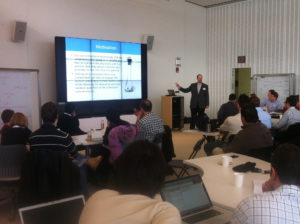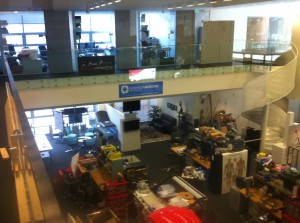I spent two weeks working in a collaborative design competition at the MIT Media Lab in Cambridge Massachusetts. Health and Wellness Innovation 2012 was a two-week hackathon that brought together students, health professionals, and innovators from industry to build technology that empowers patients to take control of their health. I stumbled on this event via the web and since I am currently between gigs I thought it might be an interesting way to exercise my creative muscles.
The event is a gathering of individuals from fairly diverse backgrounds: Media Lab students and faculty, representatives of Media Lab corporate sponsors, health professionals, and general inventive people. The focus is on coming up with innovations that will improve the quality, cost-effectiveness, and experience of health care.
Six teams are formed by the project organizers and the projects are judged on the above criteria, as well as how they make a contribution to the community by sharing some of the core technical achievements that make them work. All of the development was done as part of an open-source Adobe Flex project started by the New Media Medicine team at the Media Lab.
It was great to be part of a unique collaborative environment. It reminded me of how lucky I am to be geographically and professionally situated in such a rich and active entrepreneurial community. The team I worked with was made up primarily of participants from the Innovation Acceleration Program at Children’s Hospital in Boston. The fact that this hospital has an internal team dedicated to grassroots innovation is an indicator of the spirit of entrepreneurship there.
 During the event our team developed a prototype of an app to empower pediatric patients and their families to monitor their health after major surgery. Using gamification techniques, the application features an avatar that the patient creates pre-surgery and then interacts with after they get home.
During the event our team developed a prototype of an app to empower pediatric patients and their families to monitor their health after major surgery. Using gamification techniques, the application features an avatar that the patient creates pre-surgery and then interacts with after they get home.
When patients check off tasks involved in their recovery, like taking a medication or monitoring their fluid intake, they get points enabling them to “buy” accessories for their avatar. The idea is that these game-like incentives will get them to comply with the routines prescribed by their physicians. Hopefully this app will live on after the competition to be developed more fully at Children’s Hospital.
Our project took home third prize in the competition but it was the two weeks of energetic innovative collaboration that was the real reward for me.

Paul Franzosa is based in the greater Boston area and is a leader and technologist specializing in embedding electronics into smart devices. He has spent his career doing product development, bringing novel technologies to market, building and leading teams at startups, and managing engineering teams in diverse, international, cross-disciplinary environments covering industries that include toys, consumer products, medical devices, industrial, wireless, and public transit.
In another role, he follows his passion for youth empowerment and global learning as a volunteer leader and youth mentor in a number of cultural and socially active organizations. In his “spare time” he is a father and a husband who enjoys reading, puzzle and problem solving, game-playing, cooking, and anything to do with music.








